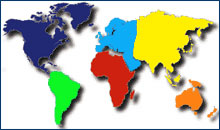| |
||
The Ultimate Adventure Packing List
What to pack for an adventure trip, how much to bring on your travels, and how to fit it all in a single carry-on with room left over for souvenirs

This is what I packed for two weeks in New Zealand. Everything on this list is in that shot—minus the luggage (pack and daypack) and the full set of clothes I was wearing. Toiletries are in the black bag; cables/charger in the maroon bag; 10 essentials in the orange sack; laundry kit in the black ditty bag. (No camping gear this trip). This is the very same packing list I use before setting off on an adventure trip (well, not the feminine stuff), whether it's a backpacking weekend, an active week in Europe, or a six-month-long research trip.
The only thing extra I bring is a laptop for work purposes.
Of course, add to this any specialty gear you need for your activities or destinations (you'll probably be bringing the ice axe and crampons—and some extra layers—to Alaska; not so much to the Sahara).
The Ten Essentials
Keep these ten essential survival items in your daypack at all times whenever heading out into the wilderness.
It sounds like a lot, but is actually all contained within that little orange stuff sack in the picture above to the left.
|
|
To the list above, I add the following three essential safety items: cell phone (turn of the phone receiver function—sometimes called "airplane mode—unless you need to make a call and the battery will easily last a long weekend) and/or two-way radios (or rent a satellite phone for real back-country work); emergency whistle (not as great a range as a cell phone, but the batteries last forever); and insect repellent (this is not just a comfort issue; dengue fever and malaria are serious problems).
A pack or bag
A pack is a very personal thing, so I merely provide a link to the REI homepage and leave it to you to pick the right one.
For the record, when I am doing an outdoors trip, I take either my 70L Gregory Baltoro (which is being replaced by the Gregory Z65 Pack), or for shorter trips my ultra-light REI Flash 50L. (Love the REI Lookout 40L, too, but it's a bit heavier.)
For a more cultural trip involving less hiking or camping, I take either an Eagle Creek Thrive 90L travel pack with a zip-off daypack (more respectable than a backpack, but not really meant for serious hiking), or a wheeled bag that has zip-away straps (for when you have to hump it—though it's not comfortable for very long).
The clothes make the traveler
The cardinal rules of adventure travel clothes: 1) No cotton (in the wilderness, cotton kills, since if it gets wet, you get colder; synthetics rule; wool is great, too); 2) Clothes you can layer; 4) Lots of pockets; and 5) Very few. Clothes take up the most space in your luggage, so don’t pack many. Just get used to doing a bit of laundry every few nights in a hotel sink.
Keeping Clean
Minimize toiletries spillage disasters by storing everything in resealable
plastic baggies. Maximize the tiny space inside a bathroom bag/toiletry kit by using sample sizes and by decanting shampoo and detergent into small, screw-top plastic bottles
—bonus, this makes them TSA safe.Keep toiletries and cosmetics to a minimum. Perfume or cologne on the road become vain deadweights and spills waiting to happen (imagine everything in your bag drenched with Chanel no. 5).
Documents & Sundries
Don’t forget to carry your most important documents—passport, plane tickets,railpass, traveler’s checks, driver’s license, and credit cards—in a moneybelt.
Carry your daily needs items in a small backpack or security purse (designed to foil pickpockets and purse snatchers).
Camping gear
If you plan to camp out, you'll also need:
Related Articles |
Outside Resources |
This article was last updated in January 2011. All information was accurate at the time.
Copyright © 1998–2010 by Reid Bramblett. Author: Reid Bramblett.



 ShareThis
ShareThis